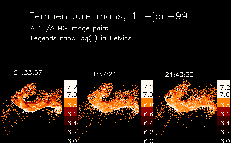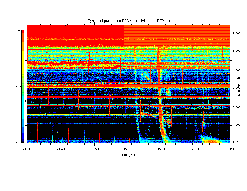
On 11-Jan we noted that an active region just south of disk center had undergone substantial changes. It appears that an eruption occurred, and a GOES C-class flare was detected. The region, NOAA active region number 8431, is shown in the image below. The individual frames in this image show the size and shape of the region at several times during 11-jan.

Most notable is the bright S-shaped spine, clearly seen in the last two frames, but detectable in the earlier frames also. At the eastern (left) end of the bright spine, one can see a sharply cusped loop. In the images made after 20:00 UT the faint plasma near the northern edge (north is towards the top of this image) appears to expand further northward and to brighten. This can be observed in a movie of the event, accessible here. A color-reversed version of this movie is accessible here.
Using SXT images in ALMG and AL12 filters, we have made maps of the plasma temperature for three times between 21:30 and 21:40 UT. The temperature maps can be seen in the image below; the legend beside each map shows the color code that corresponds to the logarithm of the temperature, from 6.0 (one million kelvins) to 7.2 (fifteen million Kelvins).

One can see that the S-shaped spine is extremely hot; the sharp eastern cusp particularly. These temperatures are taken after the inital rise-phase of the flare, as can be seen in this graph. Note the interesting striations that are visible in the central part of the spine, most clearly visible in the 21:33 temperature map. The table below is a collection of the AL.1 images, which have been contrast-enhanced to emphasize the striations.

The sharp cusp, and the loop expansion, are signatures associated with the ejection of mass. It is thought that the changes in the active region are due to a coronal mass ejection. Because of its location on the disk, a coronal mass ejection (CME) from this region at this time would very possibly be Earth-directed. Unfortunately, the LASCO instrument is currently offline; LASCO has been extremely successful at detecting Earth-directed CMEs, via the signature "halo".
Cary Oler, keeper of the Solar Terrestrial Dispatch at the University of Lethbridge, notes that "the east and west ends of the filament that meandered through the region disappeared sometime between 16:00 and 20:00 UTC (based on H-alpha imagery)". We also received notice that a Type II radio event has been detected, very likely associated with this event. The emails calling attention to this detection are reprinted here, and a graphical display of the detection is shown in the image below.

This image comes to us through the courtesy of the WAVES team, whose webpage is at URL:
Preliminary analysis suggests that shock responsible for this Type II burst was travelling at a speed of about 600 km/sec (1.3 million miles per hour, if you have trouble converting).